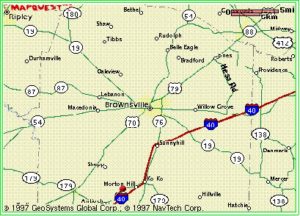 Allen’s Station, Asbury, Belle Eagle, Bethel, Brownsville, Christmasville or Castellaw Corner, Clark’s, Cliff Creek, Dancyville, Jim Dancy’s Dancyville, Eurekaton, Forked Deer, Hillville, Johnson’s Grove, Jones Station, Keeling, KoKo, Lebanon, Nutbush, Orysa, Owl City, Providence, Rudolph, Shepp, Stanton, Sulphur Springs, Sunny Hill, Tabernacle, Tibbs, Union, Wellwood, Wesley, Woodland, Woodville, Zion
Allen’s Station, Asbury, Belle Eagle, Bethel, Brownsville, Christmasville or Castellaw Corner, Clark’s, Cliff Creek, Dancyville, Jim Dancy’s Dancyville, Eurekaton, Forked Deer, Hillville, Johnson’s Grove, Jones Station, Keeling, KoKo, Lebanon, Nutbush, Orysa, Owl City, Providence, Rudolph, Shepp, Stanton, Sulphur Springs, Sunny Hill, Tabernacle, Tibbs, Union, Wellwood, Wesley, Woodland, Woodville, Zion
BETHEL: Probably settled by Bob Taylor, and later Mr. Stocton bought the land which became known as Stocton’s Bottom. In 1870 Gibson Kendrick moved here and built a sawmill. By 1875 the first school was established called Antioch at one time, then Bethel. Shortly after 1900 Bethel Church was built.
CLARKS, Eason’s Store, Harris Bluff, Cherryville: North of South Forked Deer River near the Crockett County Line, Clark’s is also known as Eason’s Store Community, and was first called Harris Bluff and then Cherryville. In the early 1800’s David Cherry and family settled here on a 1,000 acre grant and built a cotton gin, grist mill and sawmill. Cherryville was the first incorporated town in West Tennessee on October 18, 1821. Today the center of the community is at the intersection of Cherryville Road and Highway 54 North.
Fort Ridge used by the Confederates was originally a fortress build by the Indians, and Indian Mounds have been located along Forked Deer River.
FORKED DEER: Located on land granted by North Carolina in 1785 to Benjamin Smith. The first church was Presbyterian and Eureka United Methodist Church was organized in 1884 and rebuilt in 1893. The first school was established by Dr. Samuel Bain.
HILLVILLE: Located in southern part of county and first called Moore’s as the first elections were held in Alfred Moore’s home. Later it was named Hillville for Fountain P. Hill in whose home the post office was established. Mt. Pleasant United Methodist Church, “Do-Me-Good,” was organized circa 1830. Hillville was a stage coach stop between Nashville and Memphis and the coach crossed Hatchie River by ferry at Estanaula. A Chickasaw Indian Burial Ground is located here and is now part of Hatchie National Wildlife Refuge.
KOKO: Located on Highway 76 about 3 miles south of Hatchie River. It’s proximity to Lowery’s Landing at the river made it a busy area in earlier days. Some say it was named for a popular brand of chewing gum.
LEBANON: A community west of Brownsville established circa 1854 around Lebanon Methodist Church. Many years ago a Lebanon Boys’ Academy was across the road from the church.
PROVIDENCE: In the northeastern corner of Haywood County with the Madison County line through its center. Providence Methodist Church established circa 1860 and the cemetery adjoins the church.
RUDOLPH: Near Belle Eagle and settled prior to 1845 when community efforts built the first church, Zion Methodist. Originally named Brooklyn and the change was made for postal regulations.
Goodspeed, History of Tennessee, Haywood County, 1887: Brooklyn, nine miles north of Brownsville, is a post village, containing one general store, steam mills, a carriage and blacksmith shop, and two churches-white and colored Methodists.
SHEPP: Named for Thomas Sheppard who had a contract with the railroad to keep the wooden water tank filled. First called Sheppard Switch, the name was changed to Shepp by the post office department but kept the name Sheppards for freight and passenger train service.
TIBBS: First known as New York, this community was settled around 1822 and “Tibbs” was chosen from as list of twelve names submitted.
UNION: Located in East Haywood County on Highway 70 and the location of Union Grove United Methodist Church.
WELLWOOD: founded in late 1700’s and early 1800’s on the stage coach line from Jackson to Brownsille and Bells, and at one time was larger than any of the three. Businesses at its peak included a hotel and theater, post office, livery stable, blacksmith, grist mills, schools, churches, ice house, four merchantile stores and a telephone exchange.
Goodspeed, History of Tennessee, Haywood County, 1887: Wellwood, a post village ten miles east of Brownsville, contains a store, church and mechanic shop.
WOODLAND: Located in southeastern part of county and settled in early 1800’s.
WOODVILLE: Located on edge of Lauderdale County line, established about 1836 by Bowers and Eubanks families. In 1862 this was the site of a Civil War skirmish.
Goodspeed, History of Tennessee, Haywood County, 1887
Woodville is a post hamlet sixteen miles northwest of Brownsville. It was established in 1836 by Enbank and Bowers, its first merchants. Its first church was established in 1837, by Rev. Champ C. Conner, its first minister. Mr. H. I. . Anderson was its first post-master. It now contains two general stores, two churches – Methodist and Baptist – one school, a saw and grist-mill and cotton-gin, and a mechanic shop. Its population is about seventy-five souls.
ZION: Located in east Haywood Co. Zion Baptist Church established 1836 is still here, as well as several ante bellum homes and the old Cobb General Store.
